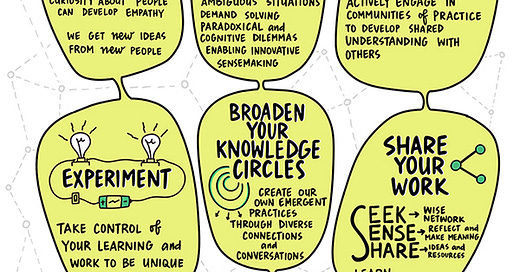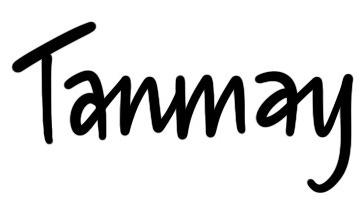Leading, Learning and Sensemaking in a Complex World
Here's some guidance on sense-making in a complex world.
Hi everyone,
Welcome to this edition of Clarity Canvas Weekly - a newsletter that goes out to nearly 2700 leaders, learners and change-makers.
In this edition, we explore lifelong learning and how to make sense in a world of information explosion.
The Challenge of Complexity
Increased complexity is a result of invisible dynamic forces, unanticipated events like pandemic, AI and rapid adoption of disruptive technologies. Making sense of all this to align yourself for a better contribution requires much more than just consuming what you come across.
Sense-making in a complex world requires us to adopt an attitude of active exploration, relentless experimentation, sound judgment and seamless collaboration with the outside world.
To make sense amidst uncertainty, we need to step out of our usual circle of the known and interact with communities that can expose us to new insights, new perspectives and challenge our thinking.
In one of my posts on Self-Directed Learning, I wrote:
What we often lack is not the resources to learn, but an intent to learn. The discipline to pursue learning in a structured way. The openness to look “beyond the syllabus” and identify topics that truly resonate with us. The courage to put ourselves out there to learn with others virtually. The motive force of execution in bringing our learning to the service of others.
Six Key Practices of Sense-making
Harold Jarche has summarized six key practices of sensemaking in a complex world, which I found very useful.
It helps to see yourself as a node in the knowledge network and find ways to become a significant node that creates, curates and contributes in taking ideas forward. Jarche says,
“There are no best practices for creativity, only unique practices, of which we need many. We need to stop looking for the next best practice and create our own emergent practices through our diverse connections.”
First, a sketchnote summary on Harold’s advice around six ways to make sense:
If you wish to see more insights on the “Seek > Sense > Share” model, please refer to this sketchnote I created on the topic “The Best Leaders are Constant Learners” by Harold Jarche and Kenneth Mikkelsen.
"Sense-making is not just about understanding the world; it's about understanding ourselves within it." - Danielle Krettek
Practical Ways to Cultivate Sense-making
In my corporate run of 25+ years, I stepped into completely new areas of work every 3 years. Jumping lanes between different functions challenged me to step up my learning and make a difference in a new area of work. This breadth of experience that I gained enabled me to climb up the proverbial corporate ladder. While doing this, I always ran my personal learning projects - mainly writing a blog but being active on social media to find communities of like-minded people where I can learn and contribute.
Transitions at work required “focused curiosity”, social media enabled me to have a “wide curiosity” around various possibilities. That is how I stumbled upon topics like visual thinking, sketchnotes, leadership coaching and change facilitation.
Based on my own experiences in lifelong learning, here are some practical ways to feed your curiosity and cultivate sense-making habits:
Prioritize time to reflect: Real learning happens when we sit down to reflect on what we experienced. Set aside regular time to synthesize and reflect on new information and experiences.
Build a Knowledge System: You can use various note taking tools that enables you to store, connect and synthesize insights in way that reflects your unique perspective. I am keen to learn Obsidian.
Engage in Specific and Broad Curiosity: Specific curiosity helps you build tangible skills in current context whereas broad curiosity allows you to map the territory to find adjacencies. Leonardo Da Vinci’s journey may help.
Embrace Slow Learning: I have written about it before, but if you eat fast food (bite-sized skimmable learning), you cannot get healthy (wise). Slow media like books, well-written blogs and podcasts allow for a more nuanced internal conversation. More here.
Use Visual Notetaking: Using simple shapes when taking notes can help you connect ideas. I have personally found using mindmaps very helpful in syntehsizing ideas. More here.
Have Right Filters: Most of us habitually scroll feed in a hope to find something useful. Search instead. Search gives you agency, makes it purposeful and keeps you focused on problem you’re trying to solve. Find and constantly curate right sources of reliable insights and knowledge.
Be a Part of Communities: Collaboration with others, contributing to conversations and engaging with diverse perspectives can expand your understanding and prompt newer questions.
Use AI Wisely and Ask Right Questions: Use AI tools to generate prompts or stimulate discussions. Asking right questions helps a great deal in clarifying concepts and gain explicit understanding on complex topics.
Practice Critical Thinking: It helps to question the sources of information you consume, engage in counter-research to fully explore the topic and verify facts. This habit of discernment goes a long way in enabling right learning.
Consume Less, Create More: Consumption can feel like an endless cycle. My formula is to consume mindfully (and less) and then create more.
Over to You: What has worked for you?
Are there any specific practices around sense-making that have worked for you? Do share in comments here, or on the blog.
From My Journal
Be fluid with your knowledge. Let it flow and grow. Keep an open mind. Let your perspectives evolve through diverse experiences. Explore multiple disciplines. Blend. Share. Learn continuously.
- Via my Instagram feed
Visual Leadership Pack of 90+ HD Sketchnotes
If you liked the sketchnote summary above, check out the Visual Leadership Pack of HD Sketchnotes – a compilation of high-resolution sketchnotes with 90+ powerful (and timeless) ideas to elevate your leadership and learning game.
That’s it for this edition. Thank you for subscribing and reading.
Until next week,
Thank you,






